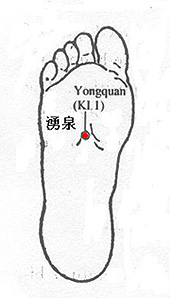Taking Cold Baths to Promote Health
 oting health by taking cold baths.
oting health by taking cold baths. The cold temperature is supposed to stimulate nerve endings in the skin to withdraw blood to the body's core. After exiting the cold bath, blood is pumped vigorously back around the body which invigorates and builds up the immune system. The vasomotor responses can positively stimulate the neural and respiratory systems and aid cardiovascular functioning. In TCM understanding, this makes the body surface firmer, and thus enhances the resistance against
TCM Cold baths can be done in many ways, for beginners, they should practice gradually and are recommended to do in the following ways:
1. Washing the face with cold water
First, dip your face into cold or ice water, exhale as long as you can through the nose, then rise up for inhalation, repeat this for 5 to 10 times. Next, use a cold wet towel to rub the face, ears and neck, then wipe with a dry towel and end by rubbing the regions with the hands until turn warm and flushed.
2. Scrubbing the body with cold water
This practice incorporates both coldness and massage. Use a cold wet towel to rub the body, the sequence for scrubbing is: face → neck → upper limbs → back → chest → abdomen → lower limbs. When rubbing the limbs, it should be from the distal to the proximal direction; this facilitates blood flow back to the heart. Initially, scrub lightly then gradually increase the force until the body surface becomes flushed and feels warm.
3. Taking cold showers
Start by splashing the limbs with cold water, use a wet cold towel to scrub the chest and back; then stand under the shower head and let cold water draining through the body, meanwhile use the towel to scrub the body. The water temperature and showering time should be adjusted according to the individual, and it should usually last for 3 to 5 minutes. Dry the body properly, keeping it relaxed, warm and comfortable.
4. Soaking the feet with cold water

Soak the feet in ice water for 1 to 2 minutes, rubbing them constantly. Wipe with a dry towel, and press the acupoint yong quan (see picture) for about 30 times on each side of the soles. Stimulating the acupoint enhances kidney and heart functioning, and also calms the spirit.
5. Taking cold baths
This involves immersing the body in a tub of ice cold water, the water temperature should be carefully monitored depending on the individual tolerance for discomfort. After staying in the water for about 0.5 to 2 minutes, leave the bathtub and immediately wipe with a dry towel, and rub the body surface till it turns slightly red. Afterwards you should feel refreshed, warm, and comfortable, be able to sleep easily and have a good appetite.
6. Winter swimming
After practicing indoors to adapt to a cold environment, you can try swimming for a few minutes at a time or taking a quick dip in a frozen lake or sea. Winter swimming improves tolerance of cold and stress.
Regular cold bathing can be one of the routine activities for health promotion. However, it should be noted that the practice is an on-going and gradual progress, always be aware how the body response about the bathing time, duration and temperature.
Individuals with serious or chronic diseases should not practice cold bathing. It should also not be undertaken during a woman's menstrual period, when pregnant, on an empty stomach, after drinking alcohol, after meals or during exercise.


